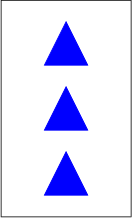题目描述
The game of Sets is a very popular card game ( http://en.wikipedia.org/wiki/Set_(game)). The game is played with a special deck of cards, where each card has a unique picture on it. This is an example of such a card:




输入
The first line of the input file contains an integer T specifying the number of test cases. Each test case is preceded by a blank line.
Each test case looks as follows: The first line contains three positive integer N, M and K giving the number of different properties of the cards, the number of different values of a single property, and the number of cards drawn.
Each of the next K lines describes one of these cards. The i-th of these lines (1 ≤ i ≤ K) contains exactly N numbers pi,j (1 ≤ j ≤ N), 1 ≤ pi,j ≤ M. Value pi,j is the value of the j-th property of the i-the card.
输出
For each test case output a single line with a single integer – the number of different Sets that can be made from the given cards.
样例输入 Copy
1
4 3 12
1 1 1 2
2 3 3 3
2 2 3 1
1 3 1 3
3 3 3 3
1 2 1 1
2 1 3 2
1 1 3 2
2 3 2 3
1 3 2 3
3 2 1 1
3 1 2 2
样例输出 Copy
11
提示
This example input corresponds to the image in the problem statement. The four properties are described in this order: shape (square, triangle, circle), count (one, two, three pieces), color (red, green, blue) and fill style (empty, striped, full).
These are the 11 different sets: (1,4,6), (1,7,12), (2,3,7), (2,6,12), (3,4,12), (3,5,8), (4,5,9), (5,11,12), (6,8,10), (7,10,11), and (8,9,11).